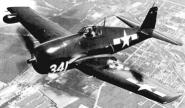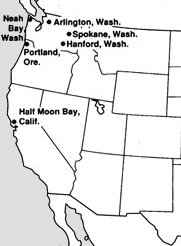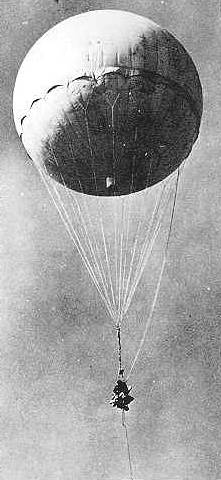The case was documented by NICAP website [nic] ufologists in a 1996 privately published book, apparently out of print, by Byron D. Varner. The author was an aviation cadet during World War II and had served as a Navy Public Affairs Officer during the last thirteen years of his naval career. He authorized the NICAP website to quote from his book [var] a part about a UFO event at the Hanford nuclear plant in July 1945.
Varner had met Rolan D. Powell, who retired as a Lieutenant Commander of the US Navy after having served in World War II aboard the aircraft carrier U.S.S. Yorktown and in Korea and Vietnam. At the time of the Hanford sighting he was 19.
Rolan Powell was then at the Naval Air Station of Pasco, Washington, where, using his combat expertise, he briefed and trained in flying new freshly trained pilots to advanced combat tactics. The base also had the mission to intercept any possibly Japanese attack on the Hanford atomic plant 60 miles from there. Although they did not know that it was the first large nuclear plant in the world, a plutonium production facility that became operational in September to provide material for atomic bombs, a vital part of the extremely secret Manhattan Project that resulted in the atomic bomb, their planes were armed and ready in case of any attack, as improbable as it seemed in the last months of World War II.

Rolan Powell |
Varner tells how on a day of July 1945, the unit was put in alert at noon time, and the pilot sent in briefing to learn that the air defence radar had detected a fast-moving object that was now motionless directly above the Hanford plant.
The pilots had to immediately take off, and arrived at the site and reaching an extreme altitude of 37.000 ft, at the limit of the normal operation ceiling of their F6F fighters (photograph below), the pilots all spotted the object at about the same time and headed directly for its position.

Gruman F6F "Hellcat". |
The pilots could not recognize what it was, but they could see that it was saucer-shaped, bright, extremely fast, and very high. They could not understand what it was despite communicating about it over the radio, and they could not reach the object.
Ground control asked them to go even higher, which was a risk the fighter planes' engines, and insisted that it did not matter if the engines are ruined. When Powell wondered what the pilots will do when the engines fail, the tower operator told him that they should "glide back towards the airport and hope that you make it."
The pilots never reached the object which stood motionless above Hanford and they indeed had to land when fuel reserve became critical and the engines started to fail one after the other due to the unreasonable altitude they had reached.
Varner specified that despite a number of witnesses, the local newspaper did not mention the incident, and says that Rolan Powell "can only surmise that the government stepped in and clamped a lid on the whole affair, according to war security measures."
Walt M. Andrus of the MUFON also took part in the investigation by locating the principal witness and interviewing him [muf].
Powell told Andrus that he does not know where the other five pilots now live not remembers their full names, but that they were pilots of a squadron of 12 veteran fighter pilots, survivors from a former squadron of 45 called Air Group III aboard the second U.S.S. Yorktown aircraft carrier. Rolan Powell did not have his flight log at hand, and estimated that the event took place six weeks before the Japanese surrendered on September 2, 1945, which puts the sighting in the middle of July 1945.
Powell told Andrus that six F6F made visual contact with the object described as the size of three aircraft carriers side by side, oval shaped, very streamlined like a stretched-out egg and pinkish in color. Powell reported that some kind of vapor was being emitted around the outside edges from portholes or vents. He speculated that the vapor was being discharged to form a cloud for disguise. The object was observed at noon in a clear sky at an estimated altitude of 65,000 feet.
The F6F's went up as high as 42,000 feet, well above their rated ceiling of 37,000 feet, but could not reach the large object, which hovered above the Hanford Nuclear Reactor for an additional 20 minutes, before going straight up as the six Hellcats gave up the intercept.

|
The Hanford nuclear plant was built as early as 1943 at a cost of Cost: $5,100,000 and it started plutonium separation on January 20, 1945. The critical state in the 2nd pile was achieved in December 1944, and a critical state in the 3rd pile in 1945. Interestingly, a Fugo balloon from the Japanese cut the power supply of a Hanford pile on February 1st, 1945. The 2nd nuclear pile in Hanford was the reactor that produced the plutonium for the Nagasaki bomb, the second to be dropped on Japan, August 9, 1945.
During the war, the Japanese had launched some 9000 "Fugo" balloons (photo on the right) from the Honshu Island towards the North American continent to start forest fires that would destroy property and divert manpower from the war effort. About 1000 reached North America, albeit without relevant results.
The US government wanted to avoid a panic and did not want the Japanese to know that their bombs had actually reached the United States, so newspapers and radio stations were asked not to release any information on the balloons. The media complied, but because of that cover-up, the public was unaware of the danger and the five people died as a result when they found a downed balloon on May 5, 1945: as kids tried to move the bomb, it exploded. The cover up was then lifted and Americans were warned of the danger.
Apparently one of them had struck a power line to Hanford possibly after having been destroyed by USN fighters, and the production at the plant was set back for three days and caused a slight delay to the Manhattan Project [han]:
"One external threat was the launching of Japanese balloon bombs. Following a United States raid on Tokyo after the Japanese bombed Pearl Harbor, the Japanese produced about nine thousand rice paper balloon bombs. Easterly winds carried them to the North American mainland, including some in the Hanford area. One of the balloons tangled in a power line that stretched between Bonneville and Grand Coulee dams resulting in a power outage at the Hanford Site. Although the power outage was shorter than a minute, it took 3 days to restore the reactors to full power (Jones 1985, Sanger 1995). For more information, see also McDowell (1993) and the Tri-City Herald (1995)."
"The Japanese balloon bombs were a real worry. Everybody at the plant was always looking up because of the statistical chance of one falling. I remember seeing 40 at one time going over. The Navy planes at Pasco chased them regularly but they had poor luck. Matthias and I went over to prod them about getting better protection. They never managed to shoot one down, although a number came down on the project, but away from buildings. The bombs never went off, but the balloons blew around and the military were a great sight trying to round these up without being blown up themselves." - Walter O. Simon quoted in Sanger 1995, p. 155"
In April 1945, as the American bombings had destroyed all the Japanese hydrogen supply, no Fugo balloons were launched anymore, so if the date "six weeks before the Japanese capitulation" is correct, there is no chance that this UFO was a Fugo balloon. However, the possibility that Rolan D. Powell did not remember the correct date remains to be disproved. (Sykhook USN balloons appeared only after WWII).
The possibility thus remains that Powell was sent to destroy a Fugo balloon, without being informed of what it was supposed to be, which was too high to be destroyed, and that later only, when UFOs became a recognized phenomenon, it remembered him of the incident which he re-interpreted as UFO incident as a result. But this possibility is not very likely, and it does not fit well the description of the UFO's size and manoeuvers as reported by Powell.

"Fugo" balloon. |
See also Radar-visual UFO sighting from plane at Hanford, December 10, 1952.